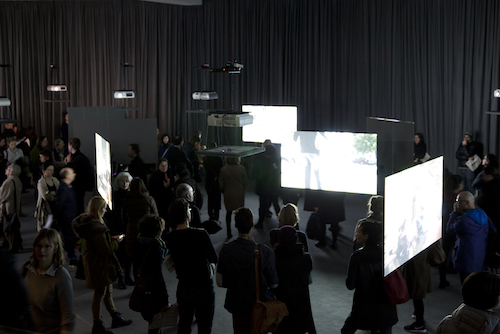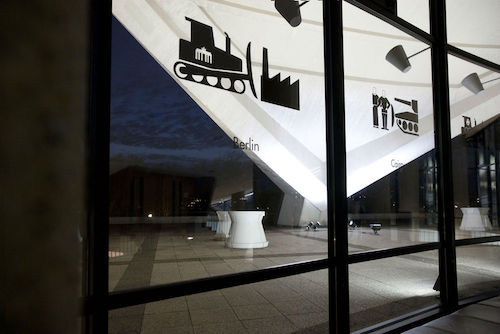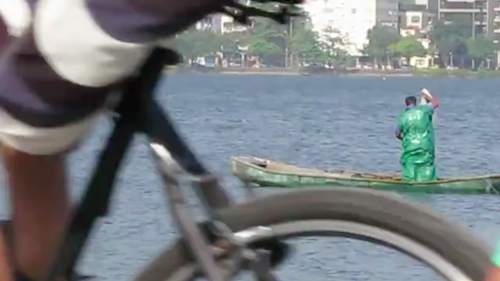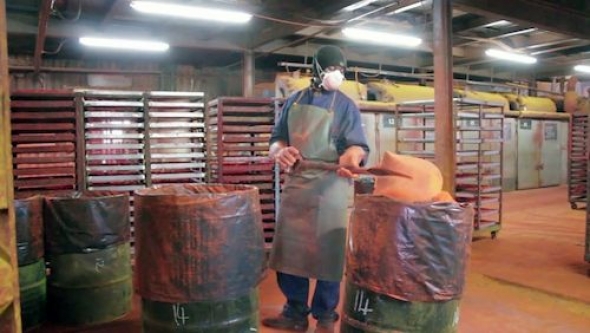Taking Potshots at Labour
In their recent networked film project, Ehmann and Farocki produce a multiply authored film installation about global labour that superimposes the problems of contemporary film onto the difficulty of representing capitalism today. Review by Sven Lütticken
Antje Ehmann and Harun Farocki’s 2011-2014 project Labour in a Single Shot (Eine Einstellung zur Arbeit) took the form of a series of workshops in 15 major cities across different continents, during which the participants were given the assignment to represent one form of labour in an extremely reductive form: a single shot of one to two minutes.
Although most of the films have sound, the form clearly harks back to ‘primitive’ cinema, and amounts to an attempt to reverse cinema’s original sin, as interpreted by Farocki: In starting with ‘workers leaving the factory’, the Lumières inaugurated cinema by repressing the work process, refusing to let the camera enter their factory. Ehmann and Farocki’s ‘single shot’ approach (and a short single shot at that) can be seen as wilful constraint in the manner of Perec or even (in cinematic terms) of Dogme. What is to be gained from such a constraint – and what is lost? What does it mean to tackle labour in the early 21st century with a form from the late 19th?
Farocki’s 2006 installation Workers Leaving the Factory in Eleven Decades combines that first film with later ‘factory gates’ films and film scenes. This installation was shown in the lobby of the Haus der Kulturen der Welt as part of the institution’s exhibition of Labour in a Single Shot. The main exhibition space not only contained a constellation of 15 projection screens showing a selection of ‘single shot films’ per city (each city being given one screen) but also, behind a semi-circular curtain, a thematic selection on 16 monitors: the Lumière film and its remakes from the 15 cities of the Single Shot project. This synchronic remake – as opposed to the diachronic, historical approach in Farocki’s earlier piece – results in some striking asynchronicities. In fact, not all the sites are factories: they include shopping malls and construction sites. The workers don’t so much leave as run from the textile factory in Bangalore once the siren sounds, while the electronic turnstiles at the ILO (International Labour Organization) in Geneva don’t see any particular rush.

Image: Installation shot, Labour in a Single Shot, Haus der Kulturen der Welt, 2015
The ‘leaving the factory’ motif foregrounds the filmic representation of labour as an ongoing, lingering problem. Watching the selection of films in the exhibition’s main installation, organised by city, it quickly becomes evident that not only are some of the participating filmmakers more successful than others in dealing with this problematic assignment, but that the approach privileges less complex and more ‘performative’ or ‘theatrical’ jobs: street performers mimicking past and present leaders in Moscow; entertainers (one dressed in a pink hippo costume) marketing a product in a supermarket in Lisbon (Rui Silveira, 2011); a bike messenger and an employee in a pet crematorium in Berlin (by Katja Hensler & Gabor Ehlers, and Antje Feitag, respectively, 2012); a singing teacher and her pupil and a guard at the Museum of Natural History in Lodz (Aleksandra Chciuk and Magda kulak, respectively, 2013). Some of the films are more anecdotal and appear spontaneously shot (especially street films), while others are more clearly premeditated and formally rigorous. The constraint at times functions as a convenient limit on what would otherwise be a formless filmic doodle; while at others, it is exploited with both formal and conceptual precision.
A criticism that can, and has, been levelled at Labour in a Single Shot is that the project ultimately relapses into a ‘Family of Man’ exoticism. Most of the cities are non-western and, when shown in Berlin, films from Bangalore such as Ox – which shows a bound ox being shoed (Suresh Gomar Gopalreddy, 2012) – have a hard time not functioning in just such a way. However, there is hardly a clear-cut division between western and non-western, or between ‘developed’ and ‘underdeveloped’ (and these two divisions are of course far from identical). In fact, there is a partial levelling in that the methodology seems to privilege street performers and manual labourers irrespective of whether they are in Boston, Berlin, Lodz or Buenos Aires. The project, then, could be faulted not so much for its exoticism as for its flaws in cognitively mapping contemporary capitalism (to use Fredric Jameson’s turn, recently revived by Alberto Toscano and Jeff Kinkle).[1] Do the Zurich films give us any real insight into Geneva as a hub of global capitalism? Did the participating filmmakers perhaps have too much autonomy, being left free to film tree surgeons rather than financiers?

Image: Alice Creischer and Andreas Siekmann’s pictorial statistics, Haus der Kulturen der Welt, 2015
This was precisely the point of departure for Alice Creischer and Andreas Siekmann’s contribution in the exhibition brochure. Creischer and Siekmann not only designed logo-type emblems for each city, which could be seen on the glass wall in the back of the exhibition space and on the Workers Leaving the Factory in Fifteen Cities monitors; in the brochure (which, sadly, was a loose-leaved newspaper that disintegrated when being consulted in the exhibition), these emblems are complemented with Otto Neurath-style ‘pictorial statistics’ pages, visualising data such as the population of the city and of the suburbs, the average income and living costs, unemployment and informal labour, organised workers, strikes and factory occupations. While these Isotype charts themselves demand a considerable labour of decipherment, they made it possible to compare the living costs and average income between Geneva and Lisbon, for instance, or the difference in living costs between white, Indian, mixed race and black Johannesburgers. There are also more specific categories for most cities – such as the number of indebted students in Boston (or rather, Massachusetts) and the death toll of the ‘war on drugs’ in Mexico.
If Creischer and Siekmann thus provides an important counterpoint and complement to the rather more impressionistic film project, Labour in a Single Shot also seems to contrast with films by Farocki such as The Interview (1996) and Words and Games (1997), or indeed 2012’s A New Product, which show protracted exchanges and production processes. Here, Farocki used protracted shoots and multiple shots – and hence montage – to show some of the complexity of contemporary labour, arriving at a form of filmic diagrammatics. A New Product deals with the ‘new work’ and the performance of the flexible ‘creative worker’ through office design and the thought processes at Quickborner Team consultancy firm; it is hard to conceive of a ‘single shot’ version of this film.
However, it would be patently false to state that Labour in a Single Shot is free of montage. In contrast to the project’s website, where all the films are presented, this exhibition presents a curated selection of films per screen—and the constellation of screens results in a parallel, spatial montage. The space becomes a zapping zone.[2] This also means that the artistic labour of the workshop participants is largely subsumed under Ehmann and Farocki’s double curatorship-as-authorship. Within the latter, Farocki is usually foregrounded since there are ample opportunities for comparisons with his filmic oeuvre. The present text obviously cannot escape these mechanisms, but they must at least be acknowledged and problematised. While the result is more than the sum of its parts, the legal status of the individual films and recompense (if any) of their makers remains unaddressed and, by consequence, extremely hazy. With its networked approach, the project is hyper-contemporary in a way that Ehmann and Farocki never fully acknowledge: here, the labour of authorship becomes such a scattered and aggregate condition that it becomes clouded.

Image: Still from Cristián Silva-Avária, The City, the Runners and the Fisherman, 2015
With his film Transformers: The Premake (2014), Farocki’s admirer Kevin B. Lee has crafted a ‘desktop documentary’ entirely from online videos, most of them taken by fans or random citizens of various Transformers 4 shoots in the US and Asia – though Lee also includes footage of an ‘epic teleprompter fail’ by director Michael Bay at a Samsung event. What is striking is that, while Paramount occasionally requests some footage to be removed from YouTube, the company nonetheless can profit from the unpaid labour of hundreds or thousands of volunteers (through some of these attempt to ‘monetise’ their videos). In our circulationist age, images are forever being performed and reperformed. Farocki’s Workers Leaving the Factory not only reperforms historical films, and was not only reperformed once again in the context of Labour in a Single Shot, but also in Alexandra Pirici and Manuel Pelmus’s Public Collection of Modern Art at the Van Abbemuseum in 2014. Here performers ‘enacted’ various artworks that included the single-channel film essay version of Farocki’s Workers Leaving the Factory – which saw them leave the exhibition space and museum, only to return and continue with their gruelling schedule.
Value is created in the process but, as with Facebook and other social media, this process is not only deliberately and systemically obscured (which calls for ‘wages for Facebook users’ seek to address), but also follows different rules. If, according to ‘Metcalfe’s law’, the value of a communication network is proportional to the square (!) of the number of its users, then quantity itself is clearly full of theological whims.[3] The classical Marxian reflex of ‘descending into the hidden abodes of production’, which sustains a good part of Farocki’s oeuvre, and Labour in a Single Shot, becomes problematic in the process. What is needed is not so much a labour theory of value, which counters commodity fetishism by showing how labour power really determines the commodity’s value, as a cloud theory of value that examines the ways in which networked capitalism transforms human labour and the creation of value – from a potentialised productivity of technology that makes a mockery of the term ‘dead labour’ to the precarisation and simultaneous intensification and extensification of many types of work.
Some particularly interesting films in this regard are Nicole Teeny’s The Writer (Boston, 2013), in which the camera pans across a messy apartment floor to show a young woman lying on bed with her MacBook, diligently typing into the tilted laptop, working in a place associated with escape from work; or Data Center in Berlin (by Marjus Bauer, Susanne Dzeik & Rene Paulokat, 2012), which shows a maintenance worker doing his rounds inside the server centre that keeps the cloud afloat.[4] However, less ‘advanced’ forms of work can hardly be said to be less contemporary; they function as part of the same global economy with all its inequities. It is contemporaneity itself that is asynchronous and fractured.
One film that manages to condense this into a single shot is Cristián Silva-Avária’s The City, the Runners and the Fisherman (Rio de Janeiro, 2012), which shows a solitary fisherman on a small boat casting his net in the background, slowly drifting on the bay, while the viewer glimpses mobile urban professionals racing by on colourful bikes in the foreground. Here, parallel montage has been incorporated into the ‘single shot’ itself, and the result is at the very least compellingly suggestive. The same can be said of Labour in a Single Shot as a whole: placing precisely observed specifics in a fragile constellation rather than abstracting from them to grand overarching theories, the project poses an aesthetic and theoretical challenge that is not likely to go away anytime soon.
Sven Lütticken <svenlutticken AT hotmail.com> teaches art history at VU University Amsterdam, where he coordinates the research master's programme Critical Studies in Art and Culture (VAMA)
Info
Eine Einstellung zur Arbeit/ Labour in a Single Shot was at the Haus der Kulturen der Welt, Berlin, from 26 February to 6 April, 2015. It was accompanied by a conference from 26-18 February.
[1] Alberto Toscano & Jeff Kinkle, Cartographies of the Absolute (Winchester/Washington: Zero Books, 2015).
[2] http://www.labour-in-a-single-shot.net The site’s users can perform a different form of editing by applying various filters to the video library. Farocki and Ehmann provide the option to filter with colours, but also with thematic categories such as ‘eye work’ and ‘factory work’, ‘monitors’, ‘muscle work’ and ‘waiting’.
The choice of categories is interesting in its own right; there is no ‘domestic labour’ or ‘reproductive labour’, for instance, so that Paolo Barretta’s film of a momentarily inattentive Brazilian nanny, Baba (not included in the Berlin show), appears under 'surveillance and control.'
[3] Jodi Dean discusses Metcalfe’s Law in The Communist Horizon (London/New York: Verso, 2012), p. 129.
[4] The site also contains another, less successful film on the same subject.
Mute Books Orders
For Mute Books distribution contact Anagram Books
contact@anagrambooks.com
For online purchases visit anagrambooks.com







